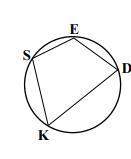
Mathematics, 21.02.2020 02:58 joshuafuller763
Alice and Bob each choose at random a number between zero and two. We assume a uniform probability law under which the probability of an event is proportional to its area. Consider the following events:
A: The magnitude of the difference of the two numbers is greater than 1/3.
B: At least one of the numbers is greater than 1/3.
C: The two numbers are equal.
D: Alice's number is greater than 1/3.
Find the probabilities P(A), P(B), P(C) and P(D).

Answers: 1
Another question on Mathematics

Mathematics, 21.06.2019 17:30
Write an expression that has three terms and simplifies to 4x - 7. identify the coefficient(s) and constant(s) in your expression
Answers: 1

Mathematics, 21.06.2019 18:40
The table shows the results of three plays in a football game. what is the net result of the three plays? football game 1st play 5 yards 2nd play -9 yards 3rd play 12 yards
Answers: 2

Mathematics, 21.06.2019 19:00
Rob spent 25%, percent more time on his research project than he had planned. he spent an extra h hours on the project. which of the following expressions could represent the number of hours rob actually spent on the project? two answers
Answers: 3

Mathematics, 21.06.2019 19:00
Aflower has 26 chromosomes. to create a new flower, how many chromosomes would a sperm cell have? what is this process called? part 2: within a flower cell that has 26 chromosomes, how many chromosomes would a cell that is created within the stem of a flower as it grows, have? what is this process called?
Answers: 1
You know the right answer?
Alice and Bob each choose at random a number between zero and two. We assume a uniform probability l...
Questions

Computers and Technology, 29.01.2021 16:50

Mathematics, 29.01.2021 16:50





Computers and Technology, 29.01.2021 16:50




Social Studies, 29.01.2021 16:50

History, 29.01.2021 16:50



Mathematics, 29.01.2021 16:50


Mathematics, 29.01.2021 16:50






